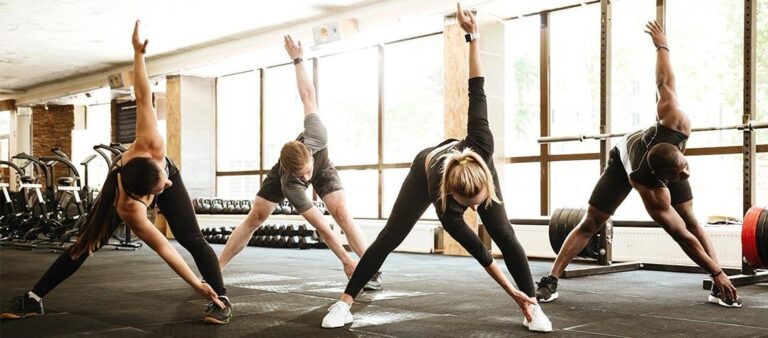in today’s fast-paced world, maintaining mobility is more than just a matter of comfort—it’s essential for overall health, injury prevention, and long-term quality of life. Whether you’re an athlete aiming to enhance performance, someone recovering from an injury, or simply looking to move more freely in daily life, improving your versatility is a crucial component of your fitness routine.This guide dives deep into essential flexibility workouts designed to boost your mobility, helping you regain range of motion, reduce stiffness, and support lasting movement for years to come. Read on to discover practical exercises and expert tips that will transform the way your body moves.
Table of Contents
- Understanding the science Behind Flexibility and Mobility
- Key Muscle Groups to Target for Enhanced Movement
- Incorporating Dynamic Stretching Into your Warm-Up Routine
- Effective static Stretching Techniques for Long-Term Flexibility gains
- Future Outlook
Understanding the Science Behind Flexibility and mobility
Flexibility and mobility are frequently enough used interchangeably, but they represent distinct physical qualities essential for overall movement health. Flexibility refers to the ability of a muscle or muscle groups to lengthen passively through a range of motion, whereas mobility encompasses the ability of a joint to actively move through its full range of motion with control and stability. Understanding this difference is critical as improving mobility involves not only stretching muscles but also strengthening the surrounding muscles and supporting structures such as ligaments and tendons. Without addressing both components,a person may gain flexibility without functional movement,increasing the risk of injury.
At the cellular level, flexibility is influenced by the biological makeup of muscle fibers and the elasticity of connective tissues. Repeated stretching encourages the production of sarcomeres—tiny contractile units within muscle fibers—while also promoting collagen remodeling in tendons and ligaments. This adaptation allows tissues to extend safely over time. Mobility, conversely, demands neuromuscular coordination, involving the brain, nerves, and muscles working together for controlled, purposeful movement.Effective mobility training combines
- dynamic stretching
- strength exercises targeting stabilizers
- proprioceptive drills
all aimed at enhancing joint function and movement quality, making it a extensive practice rather than just a flexibility routine.
Key Muscle Groups to Target for Enhanced Movement
To cultivate fluidity in your movements, focus on strengthening and loosening the hip flexors, hamstrings, and quadriceps. These muscles form the foundation for walking, bending, and squatting. Restriction in the hips can limit your range of motion, causing stiffness and even pain throughout the lower back and legs. Complementing the lower body with targeted work on the calves and glutes ensures stability and power during dynamic tasks like climbing stairs or running.
Meanwhile, the upper body plays an equally crucial role in overall mobility. Tightness in the pectorals, shoulder rotators, and spinal erectors can impair posture and reduce your ability to reach or twist comfortably.Incorporate flexibility exercises for these muscle groups to restore balance, promote better alignment, and protect your joints from overuse injuries. Consider including gentle activation and stretch routines that address:
- Deltoids and trapezius for shoulder mobility
- Latissimus dorsi for torso rotation
- Core musculature to support balanced movement patterns
Incorporating Dynamic Stretching Into Your Warm-Up Routine
Before diving into your main workout,integrating dynamic stretching can dramatically enhance your overall mobility and prepare your muscles for movement. Unlike static stretches, which involve holding a position, these stretches involve controlled, smooth motions that mimic the activity you’re about to perform. Incorporating exercises such as leg swings, arm circles, and hip rotations into your warm-up increases blood flow, raises muscle temperature, and activates the nervous system, giving you a head start on performance and reducing injury risks.
To effectively incorporate dynamic stretching into your routine, consider the following guidelines:
- Choose movements that target the muscle groups you’ll be engaging during your workout.
- Perform each stretch for 10-15 reps or about 30 seconds per side, focusing on controlled form rather than speed.
- Gradually increase the range of motion as your muscles loosen up to avoid overstretching early on.
By making these dynamic stretches a consistent part of your warm-up, you’ll prime your body for better flexibility, increased coordination, and enhanced performance throughout your workout.
Effective static Stretching Techniques for Long-Term Flexibility Gains
Achieving lasting flexibility requires more than just casual stretching—it demands precision and consistency.Focus on holding each stretch for at least 30 to 60 seconds to allow muscle fibers to relax and elongate effectively. Make sure to breathe deeply and evenly during each stretch, helping to oxygenate your muscles and reduce tension.Incorporate a gradual approach by starting with gentle stretches and progressively increasing the intensity without pushing into pain. Remember, static stretching is about sustaining a position where you feel a mild discomfort but no sharp pain, ensuring safety and effectiveness.
Integrating these techniques regularly into your routine can result in meaningful mobility improvements over time. It’s crucial to stretch major muscle groups such as hamstrings, quadriceps, calves, hip flexors, and lower back to maintain balanced flexibility. consider these tips for optimal results:
- Warm up with light cardio to increase blood flow before stretching
- Hold stretches steadily without bouncing
- Stretch daily or at least 3-4 times per week
- Use proper form to avoid injury and maximize stretch benefits
- Combine with strength training to support flexible muscles
Future Outlook
Improving your mobility is a crucial step toward maintaining an active, healthy lifestyle and preventing injury. By incorporating the flexibility workouts outlined in this guide into your routine, you’ll build a stronger foundation for movement, enhance your overall performance, and experience greater ease in everyday activities. Remember, progress takes consistency and patience—prioritize your mobility as a key component of your fitness journey, and your body will thank you in the years to come.Start today, and take the first step toward unlocking your full range of motion.

